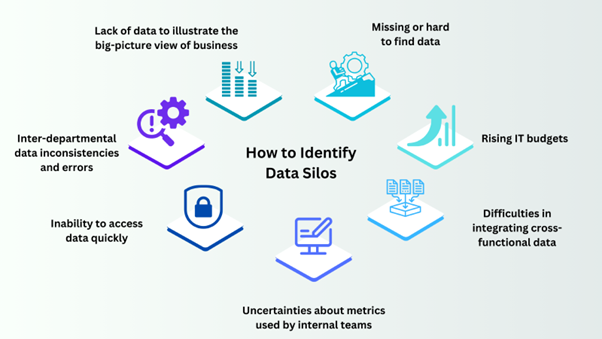Data Silos are often one of the key inter-departmental friction points within a company. Every department within an organization including sales, marketing, IT, and operations have their own set of data stored on different tools or repositories that they use. For instance, the marketing department may run campaigns through an automation tool, and the sales department may use a CRM tool to maintain customer data. Without proper integration of both these tools, it will prove difficult to attribute a single sale to a particular campaign. This consequently results in data silos and prevents data synergy between departments that could otherwise be used to enhance productivity and outcomes.
Data silos typically refer to a repository of data held exclusively by one organizational department and not easily or fully accessible to other internal groups. Siloed data fosters a lack of inclusivity and visibility and is often incompatible with other data sets.
A recent study by Forrester shows that workers lose 12 hours a week searching for key information trapped in silos.
What Causes Data Silos?
Data silos could arise from multiple factors – organizational, technical, or cultural. Some of the common causes for data silos include –
Complex organizational structure
Bureaucracy and restrictive policies in sharing data make it highly complicated for different users to access information and make informed decisions. while organizations grow and become increasingly vertical, cross-functional communication and data sharing can be faced with skepticism and internal divisions.
Multiple third-party apps and software
Multiple Saas applications are used in organizations to manage core processes and collect data. The applications used could vary across departments and in most cases, they don’t integrate with one another, resulting in silos.
Legacy storage systems
Organizations that started small or even decades ago would have historically relied on legacy storage systems. With developments in technology many of these companies are modernizing their storage applications. While leveraging new technologies allow to prepare for digital transformation and solve pressing challenges, most organizations are unaware of the data silos that arise over time. These are primarily caused due to gaps in integration between old and new systems.
Why Data Silos are Problematic?
Incomprehensive view of Data
Data collected across functions in an organization is vast. Interconnected data is often present, and when data is siloed, valuable insights that could contribute to growth opportunities are missed. Siloed data produces incomplete views of vital information and will become a roadblock in having a 360-degree view of the business.
Data inconsistencies
The same data stored in different locations causes data inconsistencies. Fragmented information may not be updated simultaneously across all the places where the data is stored. This skewed data, with time, becomes outdated and unusable. The lack of a single source of truth undermines the quality and credibility of data and can hinder key decision-making processes.
Limits Productivity
According to a Mckinsey Report – Employees spend 1.8 hours every day—9.3 hours per week, on average—searching and gathering information. When data is scattered, employees frequently invest a substantial amount of time tracking information from various sources. This translates to reduced productivity and operational inefficiency.
Security Risk
Not storing and accessing data from a centralized location could make it difficult to track who is accessing data and where they are storing it. As such, complying with data privacy rules becomes difficult. In case of a data breach, data silos in an organization would make it a tedious task to track down the source.

How to Eliminate Data Silos
Encourage cross-functional collaboration
Establishing synergy between different functions within the organization is the first step towards eliminating the challenge of siloed data. Encourage teams to consider each other as allies working toward common organizational goals.
Enable centralized Data Access
Centralized data access also translates to central governance of data. Establishing a centralized system for data storage and access helps to easily manage data access permissions. Further, this also enables businesses to track the data required by each department. Today, most businesses are using technologies like Generative AI and chatbots to help their teams access data from internal repositories.
Adopt Tools that Support Seamless Integration
Ensure that the tools used to collect and store data across the organization support seamless integration with one another. This is a good practice to keep track of all the data being generated and establish smooth flow of data within the organization. Data integration is the key for businesses to easily get rid of silos. It involves replicating data from databases, SaaS platforms, and other sources into a single centralized repositories like data warehouse. From this central repository, organizations can analyze and share data across the entire organization. Integrating disparate systems is the most effective way to avoid data silos.
Ease you Data Challenges with Kasmo
Organizations can secure independence from Data silos by implementing a sound data management strategy that is centralized and optimized for access by different teams in the organization. Kasmo has deep expertise in designing, building, and maintaining the infrastructure that enables organizations hassle-free processing, storage, and analysis of their data.

